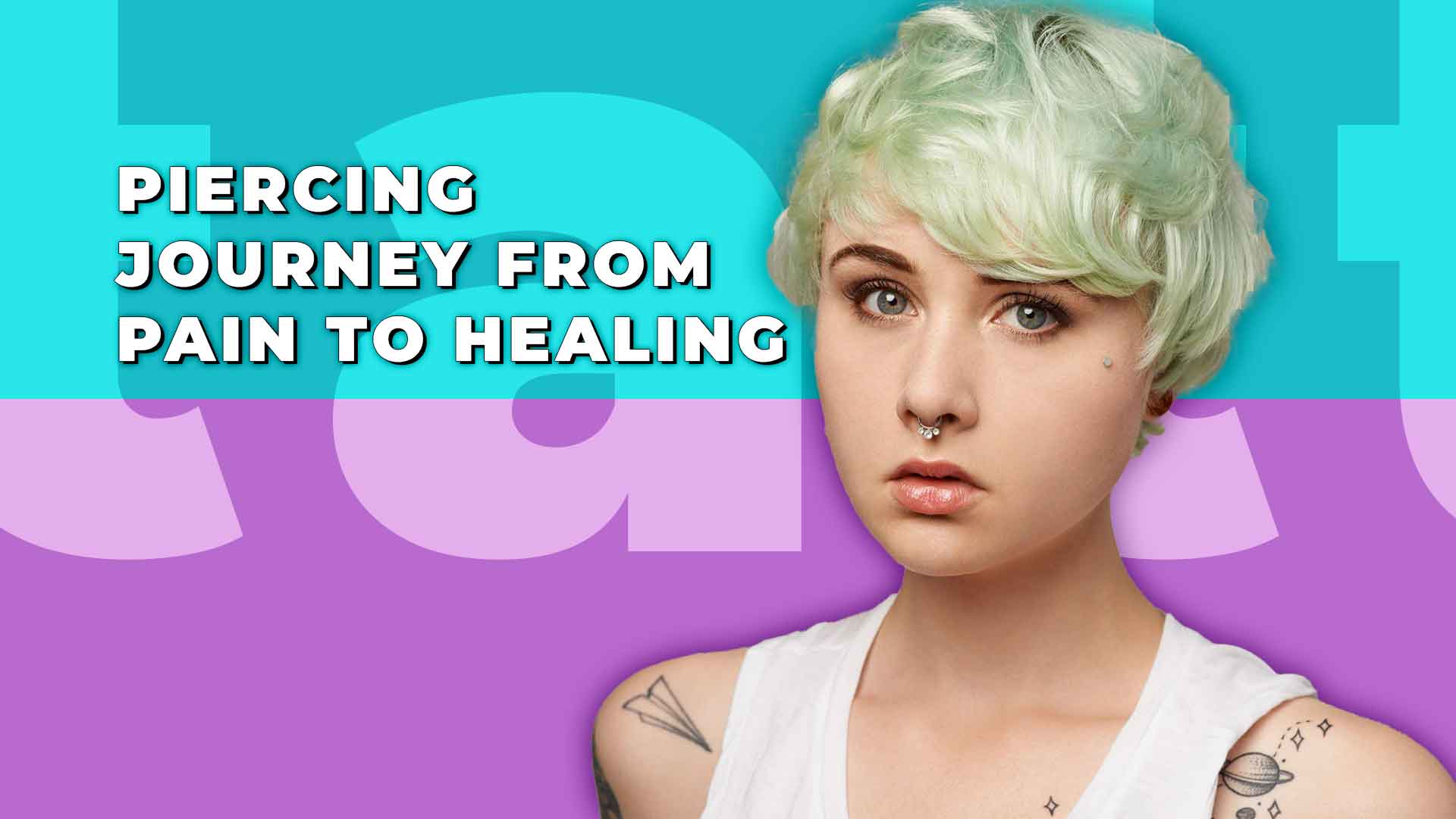Your body is a canvas, and piercings are a way to express your unique style. With so many body piercings options, knowing where to start can be overwhelming. From choosing the right piercing type and location to finding a reputable piercer and taking care of your new piercing, there are many factors to consider. Piercing is a form of body art that has been practiced for centuries. Whether you want to make a fashion statement, express your individuality, or honor cultural traditions, getting a piercing can be an exciting and meaningful experience. But piercing healing can be a long and sometimes challenging process, but with the correct aftercare, you can ensure proper healing and avoid complications.
Body piercings have recently become a popular form of self-expression and fashion statement. From ear piercings to nose, lip, navel, nipple, and even genital piercings, the options are endless. While piercings can be an exciting and meaningful addition to your appearance, it’s essential to choose the right type of piercing and get it done by a professional to ensure a safe and successful outcome. Moreover, knowing how to care for your piercing during healing is crucial for avoiding infections and other complications.
With this piercing guide, explore everything you need about body piercings, including the easiest piercings to heal, where to get them, the places on the body where you can get pierced, and beginner piercings. Also, learn the factors to consider before getting a piercing, such as pain tolerance, allergies, and healing time, as well as the proper aftercare needed for a successful healing process.
Unleash Unique Piercing Styles For Your Body Canvas

When it comes to body piercings, the options are endless. From traditional earlobe piercings to more daring genital piercings, there are many types of body piercings to choose from. One of the easiest piercings to heal is the earlobe piercing. Earlobe piercings are popular for those getting their first piercing because they’re generally less painful than other piercings and recover quickly. Healing time for earlobe piercings is usually around six to eight weeks, depending on the individual’s body and the aftercare provided.
Another popular piercing for beginners is nose piercing. The most common type of nose piercing is the nostril piercing, usually done with a small stud. Nose piercings typically take six to eight weeks to heal, and aftercare involves cleaning the piercing with a saline solution. There are several uncommon piercings to consider for those looking for something a bit more unique. Industrial piercing is one such piercing. It involves a barbell that goes through two holes in the ear’s upper cartilage. Healing time for an industrial piercing is usually around six months, and aftercare consists in cleaning the piercing with a saline solution.
The Daith piercing is another unique piercing that has recently gained popularity. It involves piercing the innermost fold of cartilage in the ear; some believe it can help alleviate migraines. Healing time for a Daith piercing is usually around three to six months, and aftercare involves cleaning the piercing with a saline solution.
Discover the Best Spots on Your Body to Pierce Your Imagination

When getting a body piercing, choosing the right place to do it is just as important as selecting the correct type of piercing. Some of the most common areas to get piercings on the body are as follows:
- Ear Piercings: Ear piercings are the most popular type of piercing, and there are several places on the ear where you can get pierced. The most common is the earlobe, but other options include the helix, tragus, and conch. It’s important to have ear piercings done by a professional piercer to ensure proper placement and avoid complications such as infections or damage to the ear cartilage.
- Nose Piercings: Nose piercings are another popular choice, and they can be done on different parts of the nose, including the nostril and septum. It’s essential to have nose piercings done by a professional piercer who uses a sterile needle and proper techniques to avoid complications.
- Lip Piercings: Lip piercings can be done on the upper or lower lip, and there are several types of lip piercings to choose from, including Labret, Monroe, and Medusa piercings. Choosing a reputable piercing studio that uses high-quality jewelry and sterile techniques to avoid infections and complications is essential.
- Navel Piercings: Navel piercings are popular for those seeking a more discreet piercing. They’re typically done on the upper or lower part of the belly button, and healing time can vary from six months to a year. It’s essential to have navel piercings done by a professional piercer to avoid complications such as infections or scarring.
- Nipple Piercings: Nipple piercings are becoming more popular and can be done on both men and women. It’s essential to have nipple piercings done by a professional piercer who uses sterile techniques and high-quality jewelry to avoid complications such as infections or scarring.
- Genital Piercings: Genital piercings can be done on both men and women, and there are several types of genital piercings to choose from, including Prince Albert, Clitoral Hood, and Labia piercings. It’s essential to select a reputable piercing studio that specializes in genital piercings and uses sterile techniques to avoid complications such as infections or damage to sensitive areas.
There are many places on the body where you can get pierced, and it’s essential to choose a professional piercer who uses sterile techniques and high-quality jewelry to avoid complications. Whether you’re getting an ear, nose, lip, navel, nipple, or genital piercing, it’s essential to do your research and choose a reputable piercing studio to ensure a safe and successful outcome.
Ready to Get Pierced? What You Need to Think About First
Before you decide to get a piercing, there are several things that you should consider to ensure a safe and successful experience. These include:
- Choose a Reputable Piercing Studio: Choosing a reputable piercing studio that uses sterile techniques and high-quality jewelry to avoid complications such as infections or allergic reactions is essential. Look for a piercing studio that is licensed, clean, and has experienced piercers who can answer your questions and address any concerns you may have.
- Research the Type of Piercing You Want: Before getting a piercing, you must research the type you want to ensure it’s right. Consider the healing time, aftercare requirements, and potential risks associated with the piercing. Some piercings may not suit everyone, so discussing your options with a professional piercer is essential.
- Consider the Placement of the Piercing: The placement of the piercing is also an important consideration. Some areas of the body may be more prone to complications, and it’s essential to discuss the risks associated with the placement of the piercing with a professional piercer. Additionally, some piercings may interfere with daily activities such as work or sports, so it’s essential to consider the practicality of the piercing.
- Understand the Aftercare Requirements: Aftercare is an essential part of the piercing process and is necessary to promote healing and prevent infections. Before getting a piercing, it’s critical to understand the aftercare requirements and commit to following them. Ask your piercer for detailed aftercare instructions and ensure you have the time and resources to care for your piercing properly.
- Consider Your Health: It’s essential to consider your health before getting a piercing. Certain health conditions or medications may interfere with the healing process, and discussing any health concerns with your piercer before getting pierced is essential. Additionally, if you have a history of allergic reactions, it’s vital to discuss this with your piercer and consider getting allergy testing before getting pierced.
Before getting a piercing, it’s essential to choose a reputable piercing studio, research the type of piercing you want, consider the placement of the piercing, understand the aftercare requirements, and consider your health. Considering these factors, you can ensure a safe and successful piercing experience.
Piercing Journey From Pain to Healing

Piercing healing is a crucial part of the piercing process that requires proper care and attention to promote optimal healing and prevent complications. The healing process for a piercing varies depending on the type and location of the piercing. Generally, most piercings take several weeks to months to fully heal. During the healing process, your body will form a protective layer of skin around the piercing, called a “piercing fistula,” which will help prevent infection and promote healing. The following tips can help promote optimal healing and prevent complications:
- Clean Your Piercing Regularly: It’s essential to clean your piercing regularly with a saline solution or gentle soap and water to remove any bacteria or debris that may accumulate around the piercing. Avoid harsh products like alcohol or hydrogen peroxide, which can irritate the skin and delay healing.
- Avoid Touching Your Piercing: Avoid touching your piercing with dirty hands or clothing to prevent the transfer of bacteria. If you must touch your piercing, wash your hands thoroughly beforehand.
- Avoid Changing Your Jewelry Too Soon: It’s essential to wait until your piercing has fully healed before changing your jewelry. Changing your jewelry too soon can disrupt the healing process and increase the risk of infection.
- Avoid Swimming and Hot Tubs: Avoid swimming and hot tubs during the healing period, as these environments can increase the risk of infection.
- Avoid Tight Clothing: Avoid wearing tight clothing or jewelry that may rub against the piercing and cause irritation.
- Avoid Using Makeup or Lotions Near the Piercing: Avoid using makeup or lotions near the piercing, as these products can introduce bacteria and irritants that can delay healing.
- Monitor Your Piercing for Signs of Infection: Monitor your piercing regularly for signs of infection, such as redness, swelling, or discharge. If you notice these symptoms, contact your piercer or a healthcare professional for advice.
Proper care and attention are essential for promoting optimal piercing healing and preventing complications. By following these tips and taking good care of your piercing, you can ensure a safe and successful piercing experience.
The Final Thought

Getting a body piercing can be a fun and exciting way to express your individuality and add some personality to your appearance. However, it’s essential to research and takes the necessary precautions to ensure a safe and successful piercing experience. Consider factors such as the type of piercing you want, the location where you want to get it done, and the reputation of the piercer. Take care of your piercing during the healing process by cleaning it regularly and avoiding activities that could irritate or infect the piercing. Remember that getting a body piercing is a personal choice that should be made carefully and thoughtfully. By following the tips and guidelines outlined in this guide, you can have a safe and enjoyable body piercing experience.

